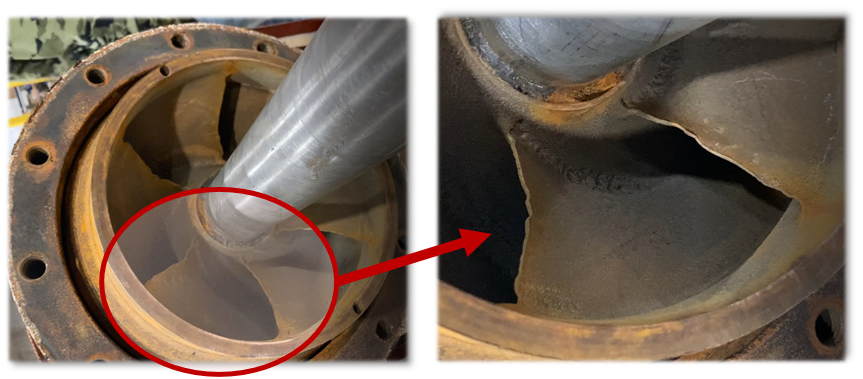Sometimes, Old Pumps Don’t Just Sound Old
Mike Assante, who manages water system capital improvements as an engineering project manager for the City of Englewood, Colo., since September 2020, has been around a lot of pumps in his career. So, when he heard about an old pump making unusual noises, he was ready to spring into action.
Category: Blogs, PSM Newsletter, PSAP, Water/Wastewater June 15, 2021
Mike Assante, who manages water system capital improvements as an engineering project manager for the City of Englewood, Colo., since September 2020, has been around a lot of pumps in his career. So, when he heard about an old pump making unusual noises, he was ready to spring into action.
Assante cut his teeth building and calibrating hydraulic models for engineering consultants, then joined Suez Water Technologies & Solutions as a project engineer and superintendent of operations. While there, he began preparing for Hydraulic Institute’s Pump System Assessment Professional (PSAP) program, which he completed after he joined Englewood.
“I had been using their guidelines for years, and it confirmed a lot of what I already knew,” he said. “But it also guided my investigations so that I considered everything I possibly could and got the diagnosis right, because pump changes have large implications.”
He got his chance to do just that when Garrett Boley, a mechanic, reported that one of his station’s pumps was making some unusual noises.
Background
Like many western municipalities, water is scarce in Englewood. The city shares water rights from a reservoir with several other cities, including Denver to the north. It also operates its own reservoir, McLellan, as backup for the region’s prolonged dry spells.
The McLellan Pumping Station ordinarily pumps between 1 million to 13 million gallons per day (MGD) into the reservoir from water leaving the Chatfield Reservoir. But when snow melts or rain falls, it can pump up to 20 MGD. This is done by four, 50-year-old, vertical turbine pumps, one of which has a variable frequency drive (VFD).
Pump 4 had been making noises for years, but it was presumed that this was how old pumps sounded. When Assante and team inspected the pump, audible rumbling near the pump shaft suggested bearing wear. When he replayed a video of the shaft taken by Boley in slow motion, they saw a distinct wobbling.
Diagnosis
To find the root cause of these problems, Assante and the Water Technology Group, a pumping solutions company out of Golden, reviewed the pump manufacturer’s original pump curve data, which showed the unit’s optimal efficiency range. They compared this data with head and flow data collected in the field to determine the pump’s actual efficiency performance.
Pump 4 was clearly running far to the right of its optimal range on its pump curve. Rather than moving water efficiently, it was generating heat, which induced progressive vibration and cavitation.
“Pumps are creatures of habit,” Assante said. “If Pump 4 was doing this today, it was almost certainly happening for years and probably since the pump was installed. The curve told me that the way we were operating this pump likely had a lot to do with its poor performance.”
Worse yet, the vibration and wobbling told him the pump could be close to large scale failure.
Water Technology Group brought in a crane and pulled the pumping unit and motor for inspection. The shaft was clearly worn on one side. The imbalance had caused the shaft to pull in one direction, wearing through the bolts that secured the pump seal.
The pump impeller was damaged due to cavitation, and debris entering the pump (Figure xx). The damage to the impeller was a likely cause of the pump imbalance and resulting vibration.

Solution
“The problem may have started because the pump was operating to the right on its curve,” Assante said. “This caused vibrations that may have shown up in the bearing initially. Then, as the impeller started to wear and deform, it accelerated the rate of pump wear.”
His solution has several aspects:
New pump. The pump was too far gone for a rebuild. Instead, Assante identified potential replacements that had pump curves that would operate cohesively with the remaining three pumps. Then he used the Hydraulic Institute’s life cycle assessment methodology to identify a pump with the lowest projected lifecycle costs. The winning pump, now being installed, cost $50,000 and is 10 percent to 20 percent more efficient than one it replaces.
Solids screening. Like most pump stations, McLellan uses an influent screen to prevent tree branches, stumps, and rocks from getting into the pump suction. Still, extensive impeller damage suggests smaller solids were likely causing problems. The engineers plan to look for different screening options to find one that removes the most offending solids with the fewest restrictions on flow.
Improved monitoring. The new pump will include pressure and flow monitors that Englewood engineers and technicians can monitor remotely. This will implement live pump curve monitoring via SCADA and enable the city to act quickly if performance starts to drift from optimal.
Englewood also plans to add remote sensors to the station’s three other pumps, which are not running optimally either. Two of them underwent $40,000 rebuilds recently that would ordinarily be good for another 10 years of service life. By using data from the sensors to improve operations, Assante hopes to extend that to 15 years.
“We can’t diagnose what we can’t track,” he said. “Once we do that, we want to show that it is not really hard to understand and diagnose these systems and really boost energy and pump performance.”
Subscribe to the Pump Systems Matter Newsletter through our Contact Us form.
SUBSCRIBE TODAY
Get the latest pump industry news, insights, and analysis delivered to your inbox.
